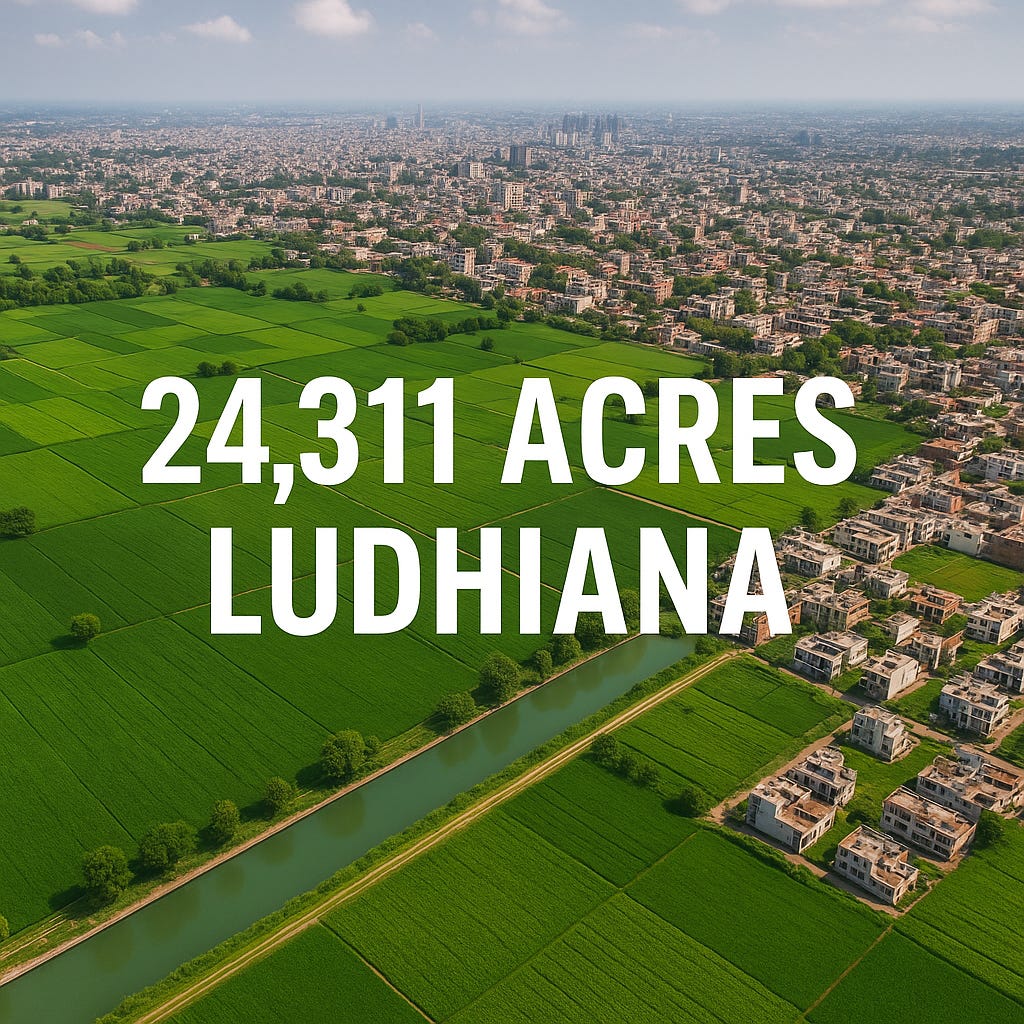Punjab's Bold Initiative: Ludhiana’s 24,311 Acre Mega Land Acquisition and the Road to Planned Urbanisation
The decision by the Punjab Government to acquire 24,311 acres of land in and around Ludhiana in one go, through the Greater Ludhiana Development Authority, is undeniably a bold move.
Massive Land Acquisition Gambit or a Visionary Leap?
The Punjab Government’s decision to acquire 24,311 acres of land in and around Ludhiana in one consolidated exercise through the Greater Ludhiana Development Authority marks one of the most ambitious urban planning initiatives in recent memory. Few State Governments have attempted a land acquisition of such magnitude in a single stroke, particularly for planned urban expansion. This unprecedented scale signals both a strong assertion of intent and a test of the State’s institutional capacity to deliver transformative infrastructure and orderly growth in one of Punjab’s most dynamic urban centres.
Putting Scale in Perspective: Chandigarh and Mohali
To put the scale of this proposed acquisition into perspective, it is important to recall that approximately 250 acres constitute one sector of Chandigarh. Since the establishment of the new capital city since the early 1950s, no more than 50 sectors have been developed over the span of seven decades. The Punjab Government’s plan to acquire 24,311 acres—equivalent to nearly 100 sectors of Chandigarh—is thus staggering in its ambition. Even in SAS Nagar (Mohali), when I served as Chief Administrator of the Punjab Urban Planning and Development Authority (PUDA) from 1999 to 2002, we undertook the acquisition of only five sectors (Sectors 76 to 80) in one go, following the abandonment of the controversial Anandgarh project. That acquisition involved merely 1,250 acres, and yet, it became entangled in prolonged litigation.
Full-fledged development of those sectors has only been recently completed—almost a quarter of a century later. In light of this, we must temper our expectations. The sheer magnitude of the Ludhiana proposal demands cautious realism. Even for a thriving metropolitan centre like Ludhiana, mega land acquisitions of this nature face considerable legal, logistical, and political hurdles. Ambition must be balanced with historical experience and implementation capacity if success is to be achieved.
The Political Roadblock: Farmers’ Resistance
What may pose a greater challenge than financing is the likely political opposition from farmers’ organisations. In Punjab, farmers have historically resisted land acquisition—even when compensation packages are relatively generous. In matters such as national highways, where the alignment is predetermined and less flexible, Punjab’s farmers have still managed to stall major projects through prolonged agitation. In the current case, where site selection for urban expansion can appear discretionary and subjective, the mobilisation potential is even greater. This dimension must not be underestimated by policymakers.
Banking on Land Pooling, Not Cash Payouts
Faced with the staggering financial implications of acquiring over 24,000 acres—where, under the provisions of the new Land Acquisition Act, the basic per-acre cost is unlikely to be less than ₹50 lakh, amounting to a total outlay of at least ₹12,000 crore—the Punjab Government appears to be banking on a land-pooling model as a strategic alternative to conventional acquisition. However, the development cost of around Rs 25-30 lakh per acre shall be an additional expenditure. Given that urban development projects of this scale typically involve a gestation period of no less than five years, the upfront financial commitment would be formidable.
The land-pooling approach sidesteps this challenge by offering landowners Letters of Intent in lieu of immediate cash compensation, promising them developed residential plots or commercial sites within the reconstituted layout. This model, at least in principle, achieves a dual objective: it significantly reduces the immediate funding pressure on the acquiring authority—such as GLADA—while simultaneously giving landowners a potentially more lucrative and tradeable stake in the future urban form.
Tradable Right to Plots: As Good As Cash
The Letters of Intent offered under the land-pooling scheme are, in practice, often treated as near-cash instruments. Their tradability makes them particularly attractive to landowners, many of whom see greater long-term value in receiving developed residential or commercial plots within the planned layout rather than a one-time monetary payout. In areas where appreciation is anticipated, these rights can command a premium even before the actual allotment takes place. For farmers, this model not only promises enhanced returns but also retains a tangible link to their ancestral land in a transformed urban context.
However, this system is not immune to manipulation. Large-scale acquisitions of this nature rarely unfold without insider leakage. Individuals with prior knowledge of impending notifications often acquire land in targeted zones ahead of time, capitalising on future compensation or plot allotments. This speculative arbitrage—while technically legal—raises ethical concerns and can distort the very intent of equitable land redistribution.
Insider Trading: From Black Money to White Assets
As a result, these speculators can successfully convert unaccounted wealth into clean, legally held and fully developed real estate. The 2013 Land Acquisition Act (effective from 2014) provides complete income tax exemption on compensation—covering not just the principal amount, but also appreciation, solatium, and any interest accrued. This converts the land acquisition process into a tacitly accepted channel for legitimising informal wealth. While this may keep many stakeholders satisfied, it also raises troubling questions about fairness, transparency, and policy design.
The Market Test: Can Supply Meet Demand?
Even if the political sensitivities and ethical dilemmas are navigated successfully, the ultimate test of this ambitious venture will rest with the market’s capacity to absorb such a vast influx of developed land. Should demand fall short, the state could be burdened with unsold inventory, leading to financial strain—particularly if the Urban Development Authority opts for institutional borrowing backed by sovereign guarantees from the Punjab Government.
On the other hand, if market absorption proves robust, the benefits could be widely distributed across the spectrum—encompassing farmers, surrogate or proxy landowners, property dealers, end-users, and the state exchequer. In that scenario, the project may well become a textbook example of inclusive and forward-looking urban expansion, with a perfect win-win scenario.
Towards Orderly Urban Growth of Ludhiana
At its best, this large-scale acquisition and planned redevelopment initiative holds the potential to break decisively from the chaotic, unregulated sprawl that has come to define much of Ludhiana’s peri-urban growth. The unchecked proliferation of unauthorised colonies, often lacking basic infrastructure and civic services, has left the city grappling with serious challenges—overcrowded residential areas, mushrooming slums, strained utilities, and a growing migrant labour population living in substandard conditions. The city’s industrial backbone, while economically vital, adds to the congestion, with haphazardly located factories and workshops contributing to noise, air, and water pollution—exemplified most starkly by the toxic state of the Budha Nala. Chronic traffic bottlenecks and inadequate transport planning further erode the quality of urban life.
Against this backdrop, a thoughtfully implemented, structured urban expansion plan could serve as a turning point. If executed well, it could facilitate the decongestion of existing urban zones, enable better integration of industrial and residential layouts, introduce sustainable infrastructure, and offer rehabilitative housing alternatives. However, success will depend not merely on economic logic or engineering prowess—it will require political sensitivity, inter-departmental coordination, rigorous transparency, and sustained trust-building with landowners and residents alike. The challenge is as much about building consensus as it is about building a city.
Conclusion: Cautious Optimism for a Transformative Step
Given that the Eco-City expansion projects in New Chandigarh—otherwise a highly sought-after urban pocket right next to the Union Territory of Chandigarh—had to be repeatedly shelved over the past decade due to a combination of legal hurdles, planning gaps, and administrative setbacks, the Punjab Government would do well to draw lessons from recent history. Its initiative to undertake one of the largest urban land acquisitions in independent India is undoubtedly a forward-looking and potentially transformative step. Yet, it must be approached with tempered expectations and cautious optimism. Experience from Chandigarh, Mohali, and major infrastructure corridors clearly shows that scale without meticulous groundwork can result in prolonged delays, litigation, and a loss of public trust. The risks of farmer resistance, speculative manipulation, legal entanglements, and market saturation are neither hypothetical nor distant—they are immediate and real.
For the Ludhiana project to succeed, it will require utmost transparency, meaningful stakeholder consultation, institutional discipline, and phased, adaptive implementation. If these pitfalls are judiciously avoided, this bold initiative could emerge as a benchmark for equitable and sustainable urbanisation—not only in Punjab, but across India.
By Karan Bir Singh Sidhu
Retired IAS officer, former Special Chief Secretary, Government of Punjab.
Extensive experience in revenue, urban planning & development and land administration, including service as Financial Commissioner (Revenue), Punjab. Writes on public administration, policy reform, and governance from a practitioner’s perspective.
.






Why is the government destroying agricultural land in Punjab?
This has been happening for a long time. Losing 24,311 acres is not a small matter—it’s a massive and unexpected loss.
The Punjab Government should evaluate how much revenue the state generates from agriculture and farming before making such decisions.
STOP SELLING AGRICULTURE LAND IN PUNJAB
#StopSellingAgricultureLandInPunjab